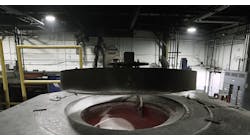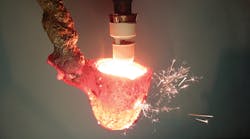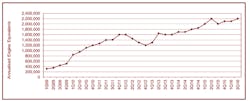SinterCast AB, the developer and licenser of foundry process technology for compacted graphite iron production, reported improved results in its latest quarterly (2Q 2016) statement, with CGI series production levels rising to offset disappointing totals from the previous quarter. The group emphasized that the ramp-up of several new series production programs during the second quarter ensured that sixth consecutive quarter of volume topping 2 million “engine equivalents” (i.e., 110,231 short tons.)
SinterCast reports series production totals as “engine equivalents,” each one equal to 50 kg. The 2Q 2016 series production total equaled the all-time high of 2.2 million engine equivalents, or 121,254 short tons.
Stockholm-based SinterCast is the world’s largest supplier of the control technology used by foundries to produce CGI — a lightweight alternative to gray iron and aluminum used mainly for automotive diesel engines and cylinder blocks, though some gasoline engine designs have been introduced in recent model years. Other applications include industrial power engines parts, ranging from 2 kg to 9 metric tons.
SinterCast president and CEO Dr. Steve Dawson commented that shipments of the group’s patented sampling cups also reached record high of 82,900 units during the first half of 2016, which is 10% over the comparable year-earlier shipment total.
“While most of the series production programs provided stable or increased volumes, a small number of programs have reported reductions during the first half of 2016,” Dawson detailed in his written comments. “These reductions were offset by gains in the remaining programs, resulting in a run-rate that was 3% higher than the 2015 full-year volume.”
The largest gain for CGI series production came from passenger vehicle programs in Europe and North America, together with the gains related to the start of production for the Cummins 5.0 liter V8 engine, for Nissan.
CGI totals related to commercial vehicle programs also rose, primarily due to a +10% total market increase (year/year) in commercial vehicle sales for Western Europe. The overall outlook remains positive, SinterCast noted, with stable series production and potential for new engine programs for passenger and commercial vehicles.
While SinterCast’s outlook for new installations remains positive, it explained that installation revenue 2016 remains behind the 2015 pace, which it related to “order timing.” A 2Q capacity upgrade for a North American customer, plus other capacity upgrades and “functionality expansions” and new installations are under discussion for the second half of 2016, the company stated.
For the April-June 2016 period, SinterCast reported revenue of SEK 18.3 million (est. $2.16 million), versus SEK 15.8 million ($1.86 million) for Q2 2015. Revenue from series production increased by 10% to SEK 16.9 million (est. $1.99 million) compared to SEK 15.4 million ($1.82 million for Q2 2015), due to the increased shipment of 46,800 (versus 34,900) SinterCast sampling cups.










